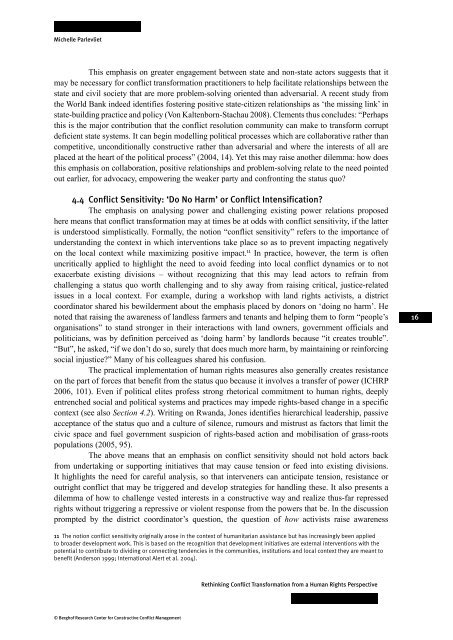Rethinking Conflict Transformation from a Human Rights Perspective
Rethinking Conflict Transformation from a Human Rights Perspective
Rethinking Conflict Transformation from a Human Rights Perspective
Create successful ePaper yourself
Turn your PDF publications into a flip-book with our unique Google optimized e-Paper software.
Michelle Parlevliet<br />
This emphasis on greater engagement between state and non-state actors suggests that it<br />
may be necessary for conflict transformation practitioners to help facilitate relationships between the<br />
state and civil society that are more problem-solving oriented than adversarial. A recent study <strong>from</strong><br />
the World Bank indeed identifies fostering positive state-citizen relationships as ‘the missing link’ in<br />
state-building practice and policy (Von Kaltenborn-Stachau 2008). Clements thus concludes: “Perhaps<br />
this is the major contribution that the conflict resolution community can make to transform corrupt<br />
deficient state systems. It can begin modelling political processes which are collaborative rather than<br />
competitive, unconditionally constructive rather than adversarial and where the interests of all are<br />
placed at the heart of the political process” (2004, 14). Yet this may raise another dilemma: how does<br />
this emphasis on collaboration, positive relationships and problem-solving relate to the need pointed<br />
out earlier, for advocacy, empowering the weaker party and confronting the status quo?<br />
4.4 <strong>Conflict</strong> Sensitivity: ‘Do No Harm’ or <strong>Conflict</strong> Intensification?<br />
The emphasis on analysing power and challenging existing power relations proposed<br />
here means that conflict transformation may at times be at odds with conflict sensitivity, if the latter<br />
is understood simplistically. Formally, the notion “conflict sensitivity” refers to the importance of<br />
understanding the context in which interventions take place so as to prevent impacting negatively<br />
on the local context while maximizing positive impact. 11 In practice, however, the term is often<br />
uncritically applied to highlight the need to avoid feeding into local conflict dynamics or to not<br />
exacerbate existing divisions – without recognizing that this may lead actors to refrain <strong>from</strong><br />
challenging a status quo worth challenging and to shy away <strong>from</strong> raising critical, justice-related<br />
issues in a local context. For example, during a workshop with land rights activists, a district<br />
coordinator shared his bewilderment about the emphasis placed by donors on ‘doing no harm’. He<br />
noted that raising the awareness of landless farmers and tenants and helping them to form “people’s<br />
organisations” to stand stronger in their interactions with land owners, government officials and<br />
politicians, was by definition perceived as ‘doing harm’ by landlords because “it creates trouble”.<br />
“But”, he asked, “if we don’t do so, surely that does much more harm, by maintaining or reinforcing<br />
social injustice?” Many of his colleagues shared his confusion.<br />
The practical implementation of human rights measures also generally creates resistance<br />
on the part of forces that benefit <strong>from</strong> the status quo because it involves a transfer of power (ICHRP<br />
2006, 101). Even if political elites profess strong rhetorical commitment to human rights, deeply<br />
entrenched social and political systems and practices may impede rights-based change in a specific<br />
context (see also Section 4.2). Writing on Rwanda, Jones identifies hierarchical leadership, passive<br />
acceptance of the status quo and a culture of silence, rumours and mistrust as factors that limit the<br />
civic space and fuel government suspicion of rights-based action and mobilisation of grass-roots<br />
populations (2005, 95).<br />
The above means that an emphasis on conflict sensitivity should not hold actors back<br />
<strong>from</strong> undertaking or supporting initiatives that may cause tension or feed into existing divisions.<br />
It highlights the need for careful analysis, so that interveners can anticipate tension, resistance or<br />
outright conflict that may be triggered and develop strategies for handling these. It also presents a<br />
dilemma of how to challenge vested interests in a constructive way and realize thus-far repressed<br />
rights without triggering a repressive or violent response <strong>from</strong> the powers that be. In the discussion<br />
prompted by the district coordinator’s question, the question of how activists raise awareness<br />
11 The notion conflict sensitivity originally arose in the context of humanitarian assistance but has increasingly been applied<br />
to broader development work. This is based on the recognition that development initiatives are external interventions with the<br />
potential to contribute to dividing or connecting tendencies in the communities, institutions and local context they are meant to<br />
benefit (Anderson 1999; International Alert et al. 2004).<br />
© Berghof Research Center for Constructive <strong>Conflict</strong> Management<br />
<strong>Rethinking</strong> <strong>Conflict</strong> <strong>Transformation</strong> <strong>from</strong> a <strong>Human</strong> <strong>Rights</strong> <strong>Perspective</strong><br />
16
















